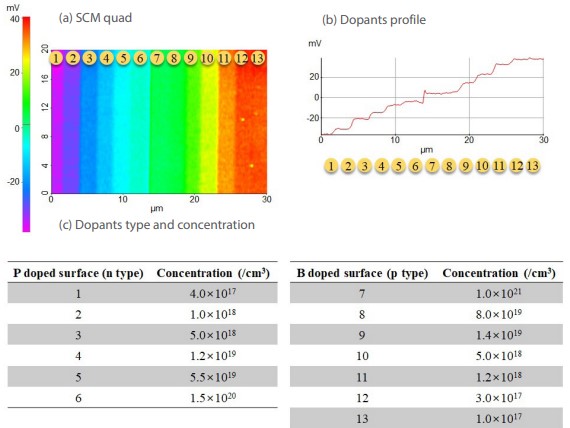
扫描电容显微镜 (SCM)
电荷分布的高分辨率和高灵敏度成像
在扫描电容显微镜(SCM)模式中,我们通过测量探针和样品之间的电容变化来获取样品表面的掺杂浓度信息。该模块允许可变谐振器频率,从而能够通过选择谐振器对特定掺杂范围最敏感的频率来监测广泛的掺杂浓度

在扫描电容显微镜(SCM)模式中,我们通过测量探针和样品之间的电容变化来获取样品表面的掺杂浓度信息。该模块允许可变谐振器频率,从而能够通过选择谐振器对特定掺杂范围最敏感的频率来监测广泛的掺杂浓度
随着半导体器件尺寸的不断减小,其电学和化学特性对于设备工程师和研究人员来说变得越来越具有挑战性。传统的半导体表征方法,如二次离子质谱(SIMS)、扩展电阻剖面(SRP)和一维电容-电压(C-V)等,无法有效地确定亚器件尺度上的功能特性。为了实现对器件尺寸持续减小的足够分辨率,并满足对其表征所需的高可靠性要求,各种类型的扫描探针显微镜(SPM)已被应用于成像器件和监测电子过程。特别是扫描电容显微镜(SCM)作为一种强大的原子力显微镜(AFM)方法,由于其非破坏性操作、高空间分辨率和电感度,被用于半导体器件的表征。
图1展示了由导电材料涂层的SCM针尖和半导体样品形成的MOS电容器结构,两者均作为电极,并在它们之间施加交流电压。
在等效电路中,半导体氧化层和耗尽层作为串联的电容器。
一般来说,SCM测量半导体上的空间电容变化,从而映射非均匀掺杂样品中的载流子浓度和掺杂分布。由于SCM能够以纳米分辨率映射局部电荷和电子缺陷,SCM在半导体工业中的故障分析应用持续增长。例如,SCM被用于表征金属氧化物半导体(MOS)器件中的栅极氧化物:随着器件整体尺寸的减小,栅极氧化物变得更薄,这可能导致器件运行过程中氧化物层中捕获电荷的问题和故障。目前,没有其他表征工具能够在二维空间中局部解析故障位置和电气缺陷。此外,SCM还用于高密度非易失性半导体存储器领域。在这里,SCM能够以纳米分辨率成像非易失性存储器中金属-绝缘体-氧化物-半导体(MIOS)异质结构绝缘层中的存储电荷。
SCM(扫描电容显微镜)除了常规的AFM(原子力显微镜)组件外,还使用导电材料涂层的AFM针尖和高度敏感的电容传感器进行操作。当导电针尖与氧化的半导体样品接触时,它们之间会形成一个MOS电容器,其中针尖和样品作为电极。这个MOS电容器由两个串联的电容器组成:一个是绝缘氧化物层,另一个是氧化物/硅界面附近的活性耗尽层,如图1所示。总电容由氧化物厚度和耗尽层厚度决定,而耗尽层厚度又取决于硅基底的载流子浓度以及针尖和半导体之间的直流电压(Vb)。 图2(下一页)展示了p型(红色)和n型(蓝色)半导体样品的电容随直流偏压电压变化的曲线,表现为高频C-V曲线。具有不同掺杂类型的样品在其C-V曲线上显示相反的斜率方向。图2(b)展示了由图2(a)中的C-V曲线推导出的差分电容随直流偏压电压变化的曲线。
图2. n型和p型掺杂半导体的电容(a)和差分电容(b)随直流偏压电压的变化,蓝色曲线代表n型掺杂半导体,红色曲线代表p型掺杂半导体。
图3. p型掺杂半导体绝缘层中正负被困电荷的影响 在p型掺杂半导体的绝缘层中,被困的正电荷或负电荷分别导致高频C-V曲线(a)和dC/dV曲线(b)中电容下降发生平行移动至较低的或较高的电压值。
绝缘层中被困电荷的存在会导致p型半导体高频C-V曲线中电容下降沿电压轴发生平行移动。根据被困电荷的性质,这种移动在C-V曲线和dC/dV曲线中分别向更高的(负电荷)或更低的电压值(正电荷)移动,如图3(a)和(b)所示。
图4. p型半导体样品中异质掺杂浓度下dC/dV测量的检测方案 锁相放大器施加的交流电压在固定直流偏压下在样品的耗尽区域产生电容变化。然后,锁相放大器检测与施加交流电压相同频率下样品电容信号的幅度和相位变化。但是,不测量absolute电容值。换句话说,锁相放大器的输出相当于差分电容(dC/dV)。因此,SCM在针尖在样品上移动时检测固定直流和交流电压下的差分电容,并以相位和幅度成像不同区域的载流子浓度。
图4. dC/dV测量的检测方案取决于半导体样品的掺杂浓度。这里以p型半导体为例。
图5. SCM工作原理示意图(a)。RF谐振频率随着针尖-样品电容的变化而发生偏移(b)。
对于图4(a)和(b)中所示的不同掺杂浓度,耗尽区域的C-V曲线斜率会发生变化。高掺杂样品的电容下降不如低掺杂浓度样品明显。在这里,通过锁相放大器检测到的SCM幅度与样品的掺杂浓度成反比。当掺杂浓度较低时,SCM幅度显示更高的对比度,因为低浓度在施加相同的VAC时会产生更厚的耗尽层,如图4所示。图5(a)展示了通过SCM进行电容测量的实验设置。它包含一个谐振电路,该电路由三条线路组成:第一条线路是一个射频(RF)源,它连接到框架模块,并包含一个相位锁定环(PLL)以生成RF信号和一个功率放大器来放大它。第二条线路是连接到RF检测器的RF接收线路。第三条线路是沿针尖延伸的电容传感器线路。针尖和样品之间的电容振荡通过RF检测线路改变谐振器的谐振特性,这导致RF接收线路输出电压幅度的差异。如图5(b)所示,在扫描过程中,由于样品电容的差异,这种RF信号会发生变化。
图6. Park Systems的SCM模式(红色)与传统SCM(蓝色)的操作频率带比较。图中绘制了不同材料的谐振曲线作为参考。Park Systems的原子力显微镜(AFM)覆盖了一个更广泛的SCM频率范围,因此能够敏感地表征多种不同的材料。
在图6中,展示了不同样品上的SCM谐振曲线。谐振曲线的形状和位置随不同材料或掺杂浓度的变化而变化。例如,金属的谐振频率相对较低,而介电材料的谐振频率相对较高。传统的SCM使用具有固定且有限的操作频率范围的RF振荡器,如图6(b)所示,这降低了金属和介电样品上的图像质量和SCM灵敏度。 另一方面,Park Systems的SCM在广泛的频率范围内运行,并具有可调频率,以选择谐振频率和品质因数来优化每次测量。SCM探针连接到一个RF谐振器,该谐振器具有一个内部可变电容器,允许调整探针以选择谐振频率和品质因数。由于灵敏度与带宽的平方根成反比(1/√BW),因此更高的频率提供了更高的灵敏度。具有可变操作频率的SCM探针覆盖了从600 MHz到2,000 MHz的广泛RF频段。这允许用户通过始终选择任何SCM谐振曲线最大斜率处的操作频率来优化分辨率和灵敏度,如图5(b)所示。 此外,SCM探针的创新电气屏蔽和介电探针座允许进行具有降低的杂散电容和增加的信噪比的测量。不仅SCM探针座重要,SCM传感器也很重要。由于SCM传感器在RF范围内工作,从谐振器到附近金属结构的电磁辐射会产生杂散电容。因此,应通过适当的绝缘和屏蔽来最小化不必要的辐射。出于这个原因,我们在探针附近的机械部件中避免使用金属材料,而是使用陶瓷材料。

图7. 具有不同掺杂浓度的P掺杂(n型)和B掺杂(p型)表面。SCM四象限图像(a)是SCM幅度和SCM相位的组合信号(SCM Quad = 幅度 × cos(相位))。SCM幅度代表掺杂浓度,SCM相位代表掺杂剂的类型。以及掺杂剂分布图(b)和样品中掺杂剂类型和浓度的规格(c)。
此外,从SCM谐振器到探针的导线长度被优化,并且谐振器前部的开口大小得到了优化。如图7所示,SCM测量能够区分具有不同掺杂浓度的n型和p型植入表面。该样品在p型Si衬底上具有n型和p型植入区域,覆盖有一层约3nm的薄氧化物层(图7(a))。编号1到6是磷掺杂的n型表面,编号7到13是硼掺杂的p型表面。图7(b)显示了具有13种不同掺杂水平和掺杂类型的掺杂剂分布图。SCM线剖面的负部分代表n型,而线剖面的正部分代表p型掺杂表面。图8(下一页)展示了使用SCM控制半导体处理参数的掺杂剂分布研究。N型多晶硅被植入绝缘体上硅(SOI)晶圆中,如图8(a)中的样品结构横截面视图所示。在退火前(图8(b))和退火后(图8(c))在样品表面顶部拍摄了形貌图和SCM四象限图像。退火过程后,SCM图像以及掺杂剂线剖面(图8(d))都发生了变化。SCM线剖面展示了n型多晶硅的明确掺杂类型和形状。
图8. n型多晶硅植入绝缘体上硅(SOI)晶圆表面的示意样品结构(a),退火前的AFM高度和SCM图像(b)以及退火后的图像(c),以及退火前(红色)和退火后(绿色)的掺杂剂分布对比(d)。